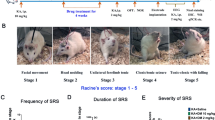Abstract
Isoniazid (INH) has neurotoxic effects such as seizure, poor concentration, subtle reduction in memory, anxiety, depression and psychosis. INH-induced toxic effects are thought to be through increased oxidative stress, and these effects have been shown to be prevented by antioxidant therapies in various organs. Increased oxidative stress may be playing a role in these neurotoxic effects. N-methyl D-aspartat receptors (NMDA) are a member of the ionotropic group of glutamate receptors. These receptors are involved in a wide variety of processes in the central nervous system including synaptogenesis, synaptic plasticity, memory and learning. Erdosteine is a potent antioxidant and mucolytic agent. We aimed to investigate adverse effects of INH on rat hippocampal NMDAR receptors, and to elucidate whether erdosteine prevents possible adverse effects of INH. In the present study, compared to control group, NMDAR2A (NR2A) receptors were significantly decreased and malondialdehyde (MDA), end product of lipid peroxidation, production was significantly increased in INH-treated group. On the other hand, administration of erdosteine to INH-treated group significantly increased NR2A receptors and decreased MDA production. In conclusion, decreasing NR2A receptors in hippocampus and increasing lipid peroxidation correlates with the degree of oxidative effects of INH and erdosteine protects above effect of INH on NR2A receptors and membrane damage due to lipid peroxidation by its antioxidant properties.
Similar content being viewed by others
References
Sarich TC, Youssefi M, Zhou T, Adams SP, Wall RA: Wright JM: Role of hydrazine in the mechanism of isoniazid hepatotoxicity in rabbits. Arch Toxicol 70: 835–840, 1996
Attri S, Rana SV, Vaiphei K, Sodhi CP, Katyal R, Goel RC, Nain CK, Singh K: Isoniazid- and rifampicin-induced oxidative hepatic injury-protection by N-acetylcysteine. Hum Exp Toxicol 19: 517–522, 2000
Martinjak-Dvorsek I, Gorjup V, Horvat M, Noc M: Acute isoniazid neurotoxicity during preventive therapy. Crit Care Med 28: 567–568, 2000
Shah BR, Santucci K, Sinert R, Steiner P: Acute isoniazid neurotoxicity in an urban hospital. Pediatrics 95: 700–704, 1995
Bal’tseva LB, Mel’nik GV, Man’ko VP: The elimination of chemotherapy side effects in pulmonary tuberculosis patients. Vrach Delo 4: 71–73, 1990
Olson KR, Kearney TE, Dyer JE, Benowitz NL, Blanc PD: Seizures associated with poisoning and drug overdose. Am J Emerg Med 12: 392–395, 1994
Anderson D, Anderson V, Pentland L, Sawyer S, Starr M, Johnson PD: Attentional function in secondary school students receiving isoniazid prophylaxis for tuberculosis infection. Epidemiol Infect 124: 97–101, 2000
Ramos A, Portero JL, Murillas J, Losada I, Martin H: Isoniazid-induced toxic encephalopathy. Rev Neurol 26: 160, 1998
Sievers ML, Herrier RN: Treatment of acute isoniazid toxicity. Am J Hosp Pharm 32: 202–206, 1975
Wason S, Lacouture PG, Lovejoy FHJr: Single high-dose pyridoxine treatment for isoniazid overdose. JAMA 246: 1102–1104, 1981
Reilly RH, Killam KF, Jenney EH, Marshall WH, Tausig T, Apter NS, Pfeiffer CC: Convulsant effects of isoniazid. J Am Med Assoc 152: 1317–1321, 1953
Fadillioglu E, Yilmaz HR, Erdogan H, Sogut S: The activities of tissue xanthine oxidase and adenosine deaminase and the levels of hydroxyproline and nitric oxide in rat hearts subjected to doxorubicin: Protective effect of erdosteine. Toxicology 191: 153–158, 2003
Yagmurca M, Fadillioglu E, Erdogan H, Ucar M, Sogut S, Irmak MK: Erdosteine prevents doxorubicin-induced cardiotoxicity in rats. Pharmacol Res 48: 377–382, 2003
Sogut S, Ozyurt H, Armutcu F, Kart L, Iraz M, Akyol O, Ozen S, Kaplan S, Temel I, Yildirim Z: Erdosteine prevents bleomycin-induced pulmonary fibrosis in rats. Eur J Pharmacol 494: 213–220, 2004
Andrzheiuk NI, Smirnova NA, Narovlianskaia SE, Novoselova VP, Kruglova EG: The pro-fibrotic and pro-oxidant action of isoniazid. Probl Tuberk 8: 7–11, 1990
Amacher DE, Schomaker SJ: Ethylmorphine N-demethylase activity as a marker for cytochrome P450 CYP3A activity in rat hepatic microsomes. Toxicol Lett 94: 115–125, 1998
Thomas BH, Whitehouse LW, Zeitz W: Metabolism of [14C]acetyliso- niazid and [14C]acetylhydrazine by the rat and rabbit. Fundam Appl Toxicol 4: 646–653, 1984
Jones HB, Cavanagh JB: Comparison between the early changes in isoniazid intoxication and the chromatolytic response to nerve ligation in spinal ganglion cells of the rat. Neuropathol Appl Neurobiol 7: 489–501, 1981
Draper HH, Hadley M: Malondialdehyde determination as index of lipid peroxidation. Methods Enzymol 186: 421–431, 1990
Lowry OH, Rosebrough NJ, Farr AL, Randall RJ: Protein measurement with the Folin phenol reagent. J Biol Chem 193: 265–275, 1951
Takagi N, Sasakawa K, Besshoh S, Miyake-Takagi K, Takeo S: Transient ischemia enhances tyrosine phosphorilation and binding of the NMDA receptor to the Src homology 2 domain of phosphatidylinositol 3-kinase in the rat hippocampus. J Neurochem 84: 67–76, 2003
Gurd JW, Bissoon N, Beesley PW, Nakazawi T, Yamamoto I, Vannucci SC: Differential effects of hypoxia-ischemia on subunit expression and tyrosine phosphorilation of the NMDAR in 7-and 21-day-old rats. J Neurochem 82: 848–856, 2002
Wittenberg GM, Tsien JZ: An emerging molecular and cellular framework for memory processing by the hippocampus. Trends neurosci 25: 501–505, 2002
Meador-Woodruff JH, Healy DJ: Glutamate receptor expression in schizophrenic brain. Brain Res Rev 31: 288–294, 1999
Lipton SA, Rosenberg PA: Excitatory amino acids as a final common pathway for neurologic disorders. N Engl J Med 330: 613–622, 1994
Hosoe H, Kaise T, Ohmori K: Effects on the reactive oxygen species of erdosteine and its metabolite in vitro. Arzneimittelforschung 52: 435–440, 2002
Hosoe H, Kaise T, Ohmori K: Erdosteine enhances mucociliary clearance in rats with and without airway inflammation. J Pharmacol Toxicol Methods 40: 165–171, 1998
Hayashi K, Hosoe H, Kaise T, Ohmori K: Protective effect of erdosteine against hypochlorous acid-induced acute lung injury and lipopolysaccharide-induced neutrophilic lung inflammation in mice. J Pharm Pharmacol 52: 1411–1416, 2000
Reiter RJ, Guerrero JM, Garcia JJ, Acuna-Castroviejo D: Reactive oxygen intermediates, molecular damage, and aging. Relation to melatonin. Ann NY Acad Sci 854: 410–424, 1998
Author information
Authors and Affiliations
Corresponding author
Rights and permissions
About this article
Cite this article
Cicek, E., Sutcu, R., Gokalp, O. et al. The effects of isoniazid on hippocampal NMDA receptors: Protective role of Erdosteine. Mol Cell Biochem 277, 131–135 (2005). https://doi.org/10.1007/s11010-005-5778-x
Received:
Accepted:
Issue Date:
DOI: https://doi.org/10.1007/s11010-005-5778-x




